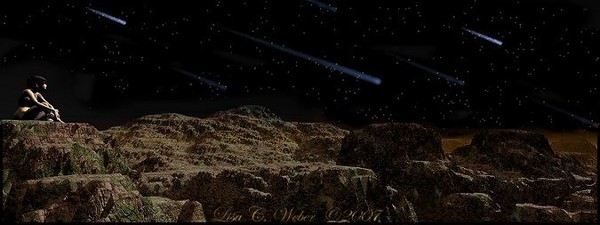- Lisa Weber
- View Portfolio
- Image 146 of 188
- Added 10 Aug 2007
- 721 Views
- 2 Comments
- Share This Image On...

The August Perseids are among the strongest of the readily observed annual meteor showers, and at maximum activity the display nominally yields 90 or 100 meteors per hour. Observers with exceptional skies often record even larger numbers. Typically during an overnight watch, the Perseids are capable of producing a number of bright, flaring and fragmenting meteors, which leave fine trains in their wake. On the night of shower maximum, the Perseid radiant is not far from the famous "Double Star Cluster" of Perseus (hence the name, "Perseid"). Low in the northeast during the early evening, it rises higher in the sky until morning twilight ends observing. Shower members appearing close to the radiant have foreshortened tracks; those appearing farther away are often brighter, have longer tracks, and move faster across the sky. About five to 10 of the meteors seen in any given hour will not fit this geometric pattern, and may be classified as sporadic or as members of some other (minor) shower. Making a meteor count is as simple as lying in a lawn chair or on the ground and marking on a clipboard whenever a shooting star is seen. Watching for the Perseids consists of lying back, gazing up into the stars, and waiting. It is customary to watch the point halfway between the radiant (which will be rising in the northeast sky) and the zenith, though it's perfectly all right for your gaze to wander. Perseid activity increases sharply in the hours after midnight, so plan your observing times accordingly. We are then looking more nearly face-on into the direction of the Earth's motion as it orbits the sun, and the radiant is also higher up. According to the best estimates, this year Earth is predicted to cut through the densest part of the Perseid stream sometime around 2 a.m. ET on Monday. That corresponds to 11 p.m. PT Sunday for those living in the western United States or Canada. The interval when the meteors will be falling at their highest rates will likely last several hours or more on either side of these times. As a result, it is the late-night hours Sunday, on through the first light of dawn Monday, that holds the greatest promise of seeing a very fine Perseid display. The moon, whose bright light almost totally wrecked last year's shower, will have zero impact this year. The moon will be new on Sunday, meaning that there will be no interference from it at all. Lisa C. Weber ©2007 (Created with Bryce 6.1) Visit My Complete Portfolio for all My 3D Rendering Artwork. Thanks for dropping by and enjoy!
2 Comments
Sandy Wiech 10 Aug 2007
Awesome!Janette Ihnatova-Dengo 10 Aug 2007
very cool!